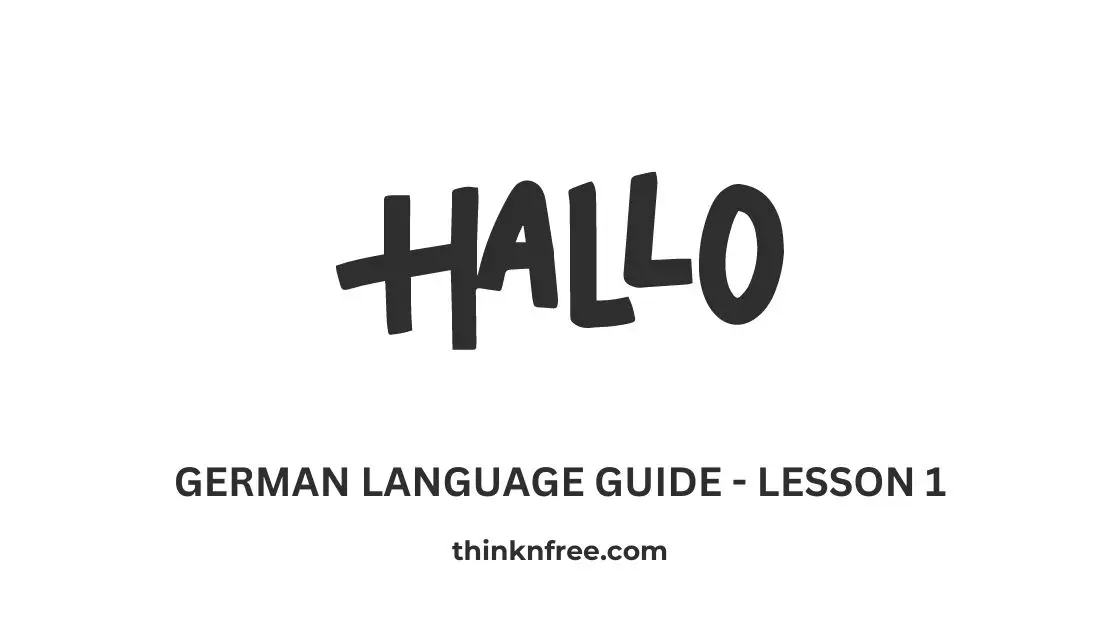Our foundation for learning the German language is the alphabet. The letters ä, ö, ü, and ß are the only ones that separate the 26-letter German alphabet from the English alphabet. Even though they are strange, these characters may be learned to be spoken and used with practice.
Free course: Free Spanish Language Course, Quick Guide to Learn Spanish
The German Alphabet
| Letter | Name (Pronunciation) |
| A | A (ah) |
| B | Be (bay) |
| C | Ce (tsay) |
| D | De (day) |
| E | E (ay) |
| F | Ef (eff) |
| G | Ge (gay) |
| H | Ha (hah) |
| I | I (eeh) |
| J | Jott or Je (yot) |
| K | Ka (kah) |
| L | El (ell) |
| M | Em (em) |
| N | En (en) |
| O | O (oh) |
| P | Pe (pay) |
| Q | Qu or Que (koo) |
| R | Er (err) |
| S | Es (es) |
| T | Te (tay) |
| U | U (ooh) |
| V | Vau (fow) |
| W | We (vay) |
| X | Ix (iks) |
| Y | Ypsilon (oopsilohn) |
| Z | Zett (tset) |
| Ä | Ä (eh) |
| Ü | Ü (uuh) |
| Ö | Ö (ouh) |
| ẞ | Eszett (ess-set) |
A – The Foundation
It is important to start with this fundamental sound since it forms the basis for so many other vowel sounds in German. The initial letter of the German alphabet, A, sounds like the “a” in “father.”
B – Like ‘B’ in ‘Bravo’
B in German is pronounced similarly to the English ‘b.’ A simple and familiar sound to start your journey through the alphabet.
C – The Chameleon Letter
C can be a bit of a chameleon in the German alphabet. It can be pronounced like ‘ts’ (as in ‘zoo’) in words borrowed from other languages, or it can be replaced by the letter ‘k’ in native German words.
D – Steady as ‘D’
D in German mirrors the English ‘d’ sound, and you’ll find it in many common words. It’s a steady and reliable letter in the alphabet.
E – A Versatile Vowel
The pronunciation of the German letter E varies depending on its location in a word and the letters around it. In rare cases, it can be pronounced like the English ‘e’ in ‘bed,’ ‘ee’ in ‘bee,’ or even ‘uh’.
F – Friendly ‘F’
F in German is quite similar to the English ‘f.’ It’s another consonant that behaves predictably in pronunciation.
G – The Soft and Hard ‘G’
G in German can be soft or hard, similar to the English ‘g’ in ‘go’ or ‘g’ in ‘giraffe,’ respectively. The pronunciation depends on the vowel following it.
H – Hush with ‘H’
H in German is pronounced the same as in English, like the ‘h’ in ‘house.’ It’s a crucial letter, as it can affect the pronunciation of neighboring vowels.
I – The Long ‘E’ Sound
I in German often has the same sound as the long ‘e’ in English, as in ‘tree.’ However, it can also be pronounced as the short ‘i’ in ‘sit’ in some cases.
J – The Gentle ‘Y’ Sound
J in German resembles the English ‘y’ sound in words like ‘yes’ or ‘yellow.’ It’s a gentle sound that adds variety to the language.
K – Clear and Crisp
K in German is straightforward and corresponds to the English ‘k’ sound. It maintains its clarity and crispness in pronunciation.
L – The Loyal ‘L’
L in German behaves like its English counterpart, sounding like ‘l’ in ‘love.’ It’s a reliable letter with consistent pronunciation.
M – Mellow ‘M’
M in German mirrors the English ‘m’ sound. It’s a mellow and melodious letter that plays a significant role in many words.
N – Nimble ‘N’
N in German, like in English, sounds like ‘n’ in ‘nice.’ It’s a nimble letter that you’ll frequently encounter.
O – The Open ‘O’
O in German can be pronounced as the open ‘o’ in English words like ‘hot’ or as a long ‘o’ sound in words like ‘note.’
P – Pronounced Like ‘P’ in ‘Paper’
P in German is pronounced the same as in English, resembling the ‘p’ in ‘paper.’ It’s a straightforward consonant to master.
Q – The Quirky ‘Q’
Q in German is relatively rare, and it’s usually followed by the letter ‘u,’ forming the ‘qu’ sound similar to the English ‘kw’ in words like ‘quick.’
R – The Rolling ‘R’
R in German can be challenging for non-native speakers due to its rolled or guttural pronunciation. It’s unlike the English ‘r’ sound, and mastering it may take practice.
S – The Sibilant ‘S’
S in German is pronounced like ‘s’ in ‘snake’ or ‘z’ in ‘zero’ depending on its position within a word. It’s a sibilant letter that adds texture to the language.
Latest Article: Learn Spanish: Your Comprehensive Guide to Getting Started
T – The Trusty ‘T’
T in German resembles the English ‘t’ sound. It’s a trusty letter with consistent pronunciation.
U – The Short ‘U’
U in German is typically pronounced as the short ‘u’ sound, similar to the ‘u’ in ‘put.’ However, it can also be pronounced as the long ‘u’ in ‘mule’ in some instances.
V – Like ‘F’ in ‘Victory’
V in German is pronounced like the English ‘f’ sound in words like ‘victory.’ It’s another letter that exhibits consistency in pronunciation.
W – The ‘V’ Sound
German w is pronounced similarly to English v, but more like a ‘v’ at the beginning of a word and more like an English ‘w’ within a word.
X – The Uncommon Letter
X in German is relatively rare and often appears in words borrowed from other languages. It’s typically pronounced as ‘ks,’ similar to the English ‘x’ in words like ‘box.’
Y – The ‘Ypsilon’
Y in German is mostly found in words borrowed from other languages and is typically pronounced like the English ‘y’ in ‘yes.’
Z – Like ‘Ts’ in ‘Pizza’
Z in German is often pronounced like ‘ts’ in words borrowed from other languages. In native German words, it’s more similar to the English ‘ts’ in ‘pizza.’
ß – The Unique Character
Finally, we have ß, known as the Eszett or “sharp S.” It’s a unique character in German and is pronounced like ‘ss’ in words like ‘hiss’ or ‘kiss.’
The umlauts, ä, ö, and ü, are marks that alter the pronunciation of the base vowel sounds in German. They are not mere decorations but carry essential phonetic and grammatical implications. Let’s delve into their individual characteristics and functions:
- Ä (Umlaut A): Pronounced like the ‘e’ in ‘bed,’ the ä sound represents a central vowel that is neither too open nor too closed. It often indicates a shift in meaning from the base word with a non-umlauted ‘a.’ For instance, “man” (man) becomes “männlich” (male), or “rat” (advice) turns into “Rätin” (female advisor).
- 2. Ö (Umlaut O): The ö sound is akin to the ‘i’ in ‘bird.’ It transforms base vowels ‘o’ and ‘u’ into a unique sound. Consider the word “Haus” (house), which transforms into “Höschen” (panties). The umlaut changes the meaning and pronunciation significantly.
- 3. Ü (Umlaut U): Representing a sound similar to the French ‘u’ in ‘tu’ or the Turkish ‘ü’ in ‘büyük,’ the ü adds a distinct dimension to the German language. For example, “tun” (to do) turns into “Tünche” (whitewash), showing how the umlaut affects both pronunciation and meaning.
Related article: Learning the German Language from Scratch
Even if navigating the German alphabet may appear difficult, you may uncover the beauty of the language by having a thorough understanding of the sounds and traits of each letter. As you immerse yourself in the language, these sounds and characters will become second nature because, as they say, practice makes perfect. With this book by your side, you’re prepared to start your language journey by learning the German alphabet, which opens up a world of connection, culture, and communication.
I’m an undergraduate and network engineer with a passion for learning new cultures and languages. I love connecting with people from different backgrounds and exploring diverse perspectives.


1 thought on “Your First Step to German Language Proficiency – Lesson 1”